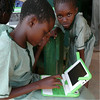One Laptop per child
 A revolutionary vision sprung up in the mind of Nicholas P. Negroponte, a Professor and senior director of the MIT Media Laboratory, known around the world for innovative use of technology, when he found how connected laptops transformed the lives of children and their families in a remote village in the South-east Asian country of Cambodia. His fertile mind started musing on the possibilities of propagating the spread of low-cost technology around the world. If every child in the third world had access to a computer, what difference would it make to the lives of those impoverished children? Will technology provide the much-needed succor to them? These questions eventually led to the foundation of “One Laptop per Child” (OLPC) project, and the creation of the “XO laptop“.
A revolutionary vision sprung up in the mind of Nicholas P. Negroponte, a Professor and senior director of the MIT Media Laboratory, known around the world for innovative use of technology, when he found how connected laptops transformed the lives of children and their families in a remote village in the South-east Asian country of Cambodia. His fertile mind started musing on the possibilities of propagating the spread of low-cost technology around the world. If every child in the third world had access to a computer, what difference would it make to the lives of those impoverished children? Will technology provide the much-needed succor to them? These questions eventually led to the foundation of “One Laptop per Child” (OLPC) project, and the creation of the “XO laptop“.
The laptop is called the XO, because if you turn the logo 90 degrees, it looks like a child!
The mission of the OLPC program is to provide children around the world with new opportunities to explore, experiment and express themselves with the use of a low-cost computer.
This ambitious project, which was started 3 years ago, has gained considerable momentum. Years of work by engineers and scientists have paid off in a pioneering low-cost machine that is light, rugged and surprisingly versatile. The milestones of the project are listed here.
 The XO Laptop is spill-proof, rainproof, dust-proof and drop-proof. It is fan-less, silent and weighs only 3.2 pounds. One battery charge will power six hours of heavy activity, or 24 hours of reading. The laptop has a built-in video camera, microphone, memory-card slot, graphics tablet, game-pad controllers and a screen that rotates into a tablet configuration. It runs on Linux, the OS OS, as its Operating System.
The XO Laptop is spill-proof, rainproof, dust-proof and drop-proof. It is fan-less, silent and weighs only 3.2 pounds. One battery charge will power six hours of heavy activity, or 24 hours of reading. The laptop has a built-in video camera, microphone, memory-card slot, graphics tablet, game-pad controllers and a screen that rotates into a tablet configuration. It runs on Linux, the OS OS, as its Operating System.
 Since November 12th, 2007, OLPC has been offering a limited-time “Give One Get One” program in the United States and Canada. During Give One Get One, you can donate the revolutionary XO laptop to a child in a developing nation, and also receive one for the child in your life in recognition of your contribution. Thanks to a growing interest in the program, we are extending Give One Get One until the end of the year. Through this extension, and the increasing public interest in OLPC, we hope to give many more children the opportunity to grow, explore, learn and express themselves.
Since November 12th, 2007, OLPC has been offering a limited-time “Give One Get One” program in the United States and Canada. During Give One Get One, you can donate the revolutionary XO laptop to a child in a developing nation, and also receive one for the child in your life in recognition of your contribution. Thanks to a growing interest in the program, we are extending Give One Get One until the end of the year. Through this extension, and the increasing public interest in OLPC, we hope to give many more children the opportunity to grow, explore, learn and express themselves.
 Under this promotion, you pay $399 for two laptops. You get one and a child in a developing country like Afghanistan, Cambodia, Haiti, Mongolia and Rwanda gets the other one. The program has been extended through Dec. 31 as donations averaged about $2 million a day. On that pace, the OLPC should move about 490,000 units by the end of the year.
Under this promotion, you pay $399 for two laptops. You get one and a child in a developing country like Afghanistan, Cambodia, Haiti, Mongolia and Rwanda gets the other one. The program has been extended through Dec. 31 as donations averaged about $2 million a day. On that pace, the OLPC should move about 490,000 units by the end of the year.
If you happen to live in those parts of the Globe, you may like to participate in this noble project too!
Watch this video to know more about the OLPC programme:
BBC has filmed the actual distribution and use of the laptops amongst the children of Nigeria. Here is a clipping:
The Man behind the Mission:
 Nicholas Negroponte, as you already know, is the founder chairman of the “One Laptop Per Child” non-profit association. He is currently on leave from MIT, where he was co-founder and director of the MIT Media Laboratory and a Professor of Media Technology. A graduate of MIT, Negroponte was a pioneer in the field of computer-aided design, and has been a member of the MIT faculty since 1966. Conceived in 1980, the Media Laboratory opened its doors in 1985. He is also author of the 1995 best seller, Being Digital
Nicholas Negroponte, as you already know, is the founder chairman of the “One Laptop Per Child” non-profit association. He is currently on leave from MIT, where he was co-founder and director of the MIT Media Laboratory and a Professor of Media Technology. A graduate of MIT, Negroponte was a pioneer in the field of computer-aided design, and has been a member of the MIT faculty since 1966. Conceived in 1980, the Media Laboratory opened its doors in 1985. He is also author of the 1995 best seller, Being Digital, which has been translated into more than 40 languages. In the private sector, Nicholas Negroponte serves on the board of directors for Motorola, Inc. and as general partner in a venture capital firm specializing in digital technologies for information and entertainment. He has provided start-up funds for more than 40 companies, including Wired magazine.